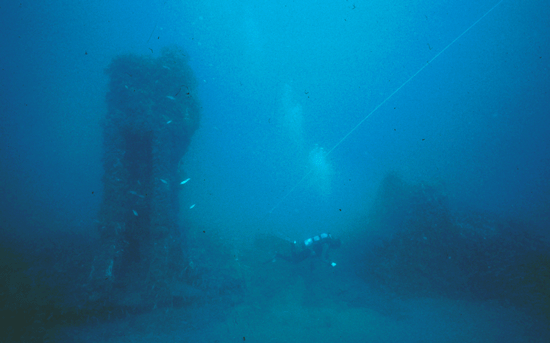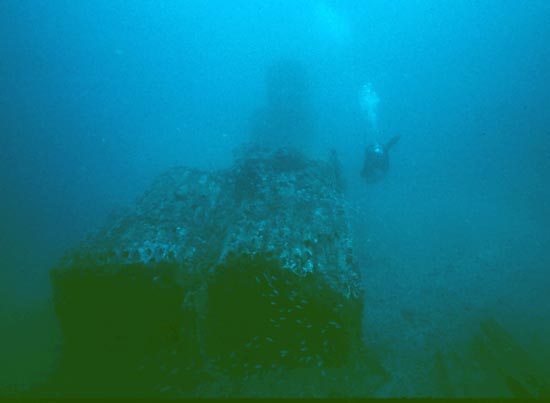 Diving the Shipwreck
Diving the Shipwreck
The Nevada sits in the same position she was last seen in by those who came to try and salvage her in 1868 - on the bottom about 7 miles due south of the Cape Hatteras Light, just a few miles offshore of the Frisco area. Her masts no longer protrude from the surface and in fact most of her wooden parts are long gone to the sea but the remains still sit upright on the sea floor. A small ship when she went down, her decay has made her a difficult target for most boats to find due to her compact size and lack of large structure. However, the wreck site is still well defined by one of her most unique features, a very tall single cylinder steam engine. This single cylinder engine rises more than 20 feet from the bottom and is the most dominant feature of the wreck site. It sits very close to what was the stern of the vessel, connected to the remnants of the fantail by a very short propeller shaft that is still directly connected to the steel/iron four bladed propeller.
 Just forward of the engine lay two rather small
square boilers that supplied the propulsion steam. The outer casings have
all but fallen away and the inner steam tubes are held tightly together by
concretion. Just forward of the boilers is a stack of railroad rails and other
debris that creates a very small debris field which then
vanishes into the sand. The Nevada, being constructed mainly of wood, has
for
the most part disappeared leaving only the heavy machinery and some of her
cargo behind. There is no hint of the bow section or any of her other
structures, masts or rigging.
Just forward of the engine lay two rather small
square boilers that supplied the propulsion steam. The outer casings have
all but fallen away and the inner steam tubes are held tightly together by
concretion. Just forward of the boilers is a stack of railroad rails and other
debris that creates a very small debris field which then
vanishes into the sand. The Nevada, being constructed mainly of wood, has
for
the most part disappeared leaving only the heavy machinery and some of her
cargo behind. There is no hint of the bow section or any of her other
structures, masts or rigging.
 The entire wreck site can be swam in less
than ten minutes and does not provide the relief and great visual drama of most
of the other Hatteras area sites. She also sits in an area known as the
"bad bottom" since in this region just South of the shoals the sands
are muddier than we find at other sites. This often results in lower visibilities
of 30 to 40 feet at this site and sometimes less than that. Since the
wreck is not particularly picturesque and the viz often not stellar, the Nevada
has gained a reputation as a "diggin wreck" or one that you go to to
search for artifacts. The site has produced some very good
finds over the years and in fact was originally often referred to as "The Urn
Wreck" for the earthen wear urns that have been recovered from the muddy
sands. The urns are slightly smaller in size than a five gallon bucket and
have a somewhat cylindrical shape with a fairly tight fitting lid. Pieces
of them are often found around the wreck site as well as many other small
artifacts to include other ceramic items, brass lantern pieces, rifle and gun
remnants and other general
merchandise.
The entire wreck site can be swam in less
than ten minutes and does not provide the relief and great visual drama of most
of the other Hatteras area sites. She also sits in an area known as the
"bad bottom" since in this region just South of the shoals the sands
are muddier than we find at other sites. This often results in lower visibilities
of 30 to 40 feet at this site and sometimes less than that. Since the
wreck is not particularly picturesque and the viz often not stellar, the Nevada
has gained a reputation as a "diggin wreck" or one that you go to to
search for artifacts. The site has produced some very good
finds over the years and in fact was originally often referred to as "The Urn
Wreck" for the earthen wear urns that have been recovered from the muddy
sands. The urns are slightly smaller in size than a five gallon bucket and
have a somewhat cylindrical shape with a fairly tight fitting lid. Pieces
of them are often found around the wreck site as well as many other small
artifacts to include other ceramic items, brass lantern pieces, rifle and gun
remnants and other general
merchandise.
The wreck's identity was believed to be the Nevada from researching the Lloyd's reports and matching the configuration of the machinery to vessels lost on Hatteras. Some uninformed diver named the wreck site the "Unis" and that name was in general use for several years. But the "Unis" identification was far from positive and not based upon facts. The wreck was positively identified as the Nevada when local Hatteras diver Steve Lang discovered a small pewter spoon which had the name "Nevada" embossed in the handle. This artifact along with the engine configuration made the identity of the wreck positively known.

The high value placed on this wreck at the time of her loss has led divers to believe there must have been cargo onboard far more valuable than common brass lantern parts and the other general merchandise they had been finding. Several seasons ago a private dive boat spent most of the Summer at this site digging around for "treasure". However, there is no great treasure of gold or silver at the Nevada just some interesting trinkets and a shipwreck history to be learned. Forward of the ship's boilers and slightly off to the starboard side the remains of a small round boiler is located. Nearby this small boiler are several large round disks which at first appear to be nothing of significance. But after much examination and some thought, they will reveal themselves to be large train car wheels and the clue to why this wreck had such great value at the time of her loss. The round boiler and wheels along with some large framing and two steam pistons belong to the remnants of a steam locomotive, which in the 1800's was a very expensive and valuable object indeed.
The Nevada is not known as one of the better Hatteras area sites, but she is worth at least a dive to visit an old steamer wreck to view the unusual engine and other items of interest there. Besides, you might get lucky, find some treasure, and prove me wrong.